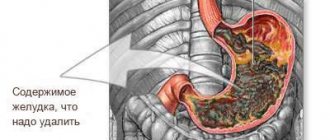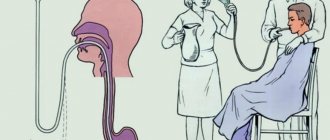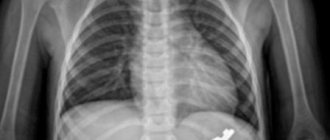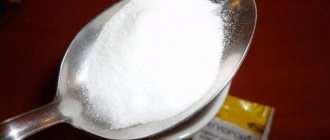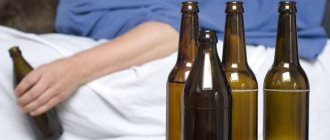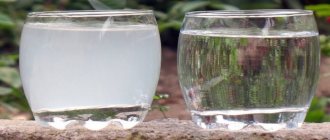In case of poisoning, a saline solution is used to stabilize the water-electrolyte balance and relieve signs of intoxication. Due to disorders of the gastrointestinal tract (vomiting and diarrhea), the human body becomes dehydrated, losing vital mineral salts along with water.
In case of poisoning, a saline solution stops the manifestations of intoxication and promotes rapid recovery of strength after illness. To do this, the sick person is given water and salt, which they make themselves or purchase at the pharmacy.
Indications for use
A water-salt solution should be used in the following cases:
When all the symptoms of dehydration occur (doctors call dehydration “exicosis”). This is the main and main indicator for the use of the solution. The fact is that when dehydrated, the body loses fluid very quickly, and this leads to irreversible consequences or even death.
If a person loses a tenth of all the fluid in the body, irreversible consequences will occur in the form of damage to internal organs and disruption of all systems. If he loses a fourth part, the result is, at best, shock, and most likely death!
Diarrhea, discomfort in the stomach or intestines, fever and other symptoms of poisoning. All this one way or another leads to dehydration. Even if the symptoms of exicosis have not yet appeared, but the patient does not feel better (the stomach still hurts, the temperature is high, nauseated, and so on), it means that dehydration will soon occur. This must be prevented. Acute intestinal infections. Any intestinal toxin (cholera, halophilia, rotavirus, adenovirus, escherichiosis and others) can affect both the stomach and intestines. You can recognize this by symptoms such as acute pain in the stomach, nausea, vomiting after eating, dizziness, aches, pain in the lower abdomen (the most basic symptom). Also, in this case, there is stool with impurities of mucus and blood (sometimes of an unnatural color, for example green, it can also be of an unnatural consistency, for example, too liquid), painful acts of defecation and urination.
Dehydration can be recognized by symptoms such as persistently pale skin, especially on the face, extreme thirst, dry mouth, dark yellow urine, dizziness and weakness . During the manifestation of symptoms of poisoning, it is necessary to constantly monitor the patient and respond to any change in his condition. It is best to consult a doctor, even if the patient feels better after taking a water-salt solution or any other drugs used for poisoning.
What to do to stop vomiting?
Although most cases of vomiting require calling a doctor, parents should begin helping their child with vomiting as soon as this uncomfortable symptom appears.
The main actions of parents should be:
- The child should be reassured, since vomiting always frightens children. Bed rest is recommended, with the head elevated and turned to the side. If the child is an infant, it is better to keep him upright for a while after vomiting.
- After each episode of vomiting, you should rinse your child's mouth with warm, clean water.
- The main goal of parents before the doctor arrives should be to ensure that the baby has enough fluids, because the biggest danger of vomiting is the loss of important minerals and water by the child’s body.
- Until the doctor determines the cause of vomiting, the child should not be given any medications. Also, you should not temporarily feed the child except for infants (breastfeeding or bottle feeding is not interrupted).
The effect of using a water-salt solution
The most important thing that a water-salt solution does is replenish fluid reserves. In general, during full-fledged poisoning (all symptoms at once) or even with diarrhea or other individual manifestations of poisoning, it is important to drink as much as possible. Once in the stomach, toxins begin to accumulate and cause vomiting. During one attack, a person loses up to 1.5 liters of fluid. Even if such attacks are not observed, up to 3 liters of water still leaves the patient’s body. Therefore, it is extremely important to replenish your water supply. But ordinary drinks are completely unsuitable for performing such tasks, especially if it is sweet water or some kind of cocktails.
If the fluid supply in the patient’s body is not replenished in time, toxins enter the bloodstream, then into the liver, kidneys and other organs, which leads to their damage. When there is no water in the body, it simply does not fight toxins.
A water-salt solution best copes with the task of replenishing fluid in the human body. Any doctor will tell you this. As for water, why it is effective was discussed above. Salt will also be very useful for all kinds of poisoning. This can be said for the following reasons:
salt restores the concentration of trace elements that help fight the effects of toxins; salt can stimulate the process of neutralizing the toxins themselves; salt restores the supply of electrolytes that the human body loses during poisoning (and in large quantities); if it is sodium salt (regular salt, which is sold in stores and supermarkets), it stops the absorption (absorption) of toxins into the stomach walls.
The latter can be considered the most important property of salt. Toxins usually enter the stomach, accumulate there, begin to penetrate the walls, destroy them, and only then enter other organs. Accordingly, if toxins act in the patient’s body for too long, their effect will be irreversible, because the walls of the stomach will remain damaged. But if you use salt, it will prevent toxins from being absorbed into the walls, so they will simply accumulate in the stomach and come out with vomit . In this case, this is the best option.
Therefore, the most ordinary water with salt can greatly help the patient cope with toxins. Thanks to it, the infection will not penetrate further than the stomach, and the body receives the necessary amount of water. But to achieve this effect, you need to know how to use the water-salt solution correctly.
How to use saline solution for poisoning
The preparation of a water-salt solution consists of the following steps:
Take 3 liters of water and heat it to room temperature (20-25 degrees), before bringing it to a boil. This is important because if the solution is too hot or cold, it will cause stomach spasms, which will be additional stress for him. Add sugar, salt and soda. Most doctors advise taking one tablespoon of sugar and salt per liter of water. As for soda, you need to take 0.5 tablespoons per liter of water. Mix all the components so that nothing remains at the bottom and a homogeneous solution is obtained.
As for how to drink salt water if poisoned, it all depends on the degree of the disease . So, if poisoning is only in the initial stages and there are no signs of dehydration, you can take 200 ml of the solution after each manifestation of poisoning (diarrhea or vomiting). If the poisoning has reached a fairly serious stage, doctors advise drinking a water-salt solution in small sips, taking a break of 10-20 minutes after each liter drunk.
If serious signs of dehydration are observed, doctors recommend drinking 60-70 ml of a water-salt solution for each kilogram of weight (for example, if the patient weighs 80 kg, he needs to drink 60 * 80 = 480 mg, that is, almost 5 liters of solution) . This should be done a maximum of 10 hours after symptoms appear. In this case, you should definitely contact a doctor and call him at home.
Features of using a water-salt solution
A water-salt solution is not the main treatment. It must be used in combination with other medications and therapies. By itself, this solution will not be able to fully cope with poisoning . This remedy should not be used if there are ulcers or inflammations in the stomach or duodenal area. And in general, if there is inflammation in any of the organs of the gastrointestinal system, it is better not to use this solution. If vomiting is caused after taking a water-salt solution, you need to rinse your mouth with plain water and drink the solution again. The end result of taking a water-salt solution is that vomiting and other signs of poisoning completely disappear. Accordingly, the solution must be used until the symptoms of poisoning cease to appear. If the patient has a rotten smell and bitterness in the mouth, alternating constipation with diarrhea and too frequent urge to vomit or diarrhea, the patient urgently needs to be hospitalized! Be sure to consult a doctor for any type of poisoning !
In addition, it is important to understand that in the case of poisoning in children, a water-salt solution is used differently. All of the above recommendations apply to adults only!
Solution for children
The saline solution for vomiting in children and how to make it are no different from the same solution for adults (the recipe remains the same). But even with the most severe manifestations of poisoning, the solution itself needs to be given much less. The maximum amount of water-salt solution for children is 50 ml per kilogram of weight . Initially, the child is given no more than one teaspoon every 10 minutes. If the manifestations of poisoning are not very strong, 10 ml will be enough.
Only the attending doctor can tell you exactly how much solution should be given to the child! Don't risk your baby's health.
How much should I drink?
The volume of water-salt solution consumed depends on the form and severity of poisoning and the patient’s condition. Take the medicine in small quantities so as not to cause a gag reflex.
- At the first stage of poisoning and in the absence of symptoms of intoxication, the victim is recommended to drink a glass of saline solution after each vomiting or diarrhea.
- At a serious stage of intoxication, it is necessary to drink a liter of salt solution in small sips every twenty minutes.
- For symptoms of dehydration, consume 70 mg of a medicinal salt drink per kilogram of body weight. This amount must be drunk no later than ten hours after the poisoning occurred.
Regidron - an alternative to a homemade water-salt solution
A good alternative to a water-salt solution is rehydron . Rehydron contains the following components:
sodium chloride (aka regular kitchen salt); dextrose (sugar); potassium chloride, which is responsible for normalizing the alkaline balance (this is important if you want to avoid the consequences of poisoning as much as possible); sodium citrate, which is responsible for normalizing the acid balance.
As you can see, there are all the components that are used in a regular water-salt solution, except for soda. But there is sodium citrate and potassium chloride . It is even better. Usually the packages indicate how the medicine should be used and its dosage. But in most cases it is used in the same way as a regular water-salt solution - after each manifestation of poisoning or every 10 minutes.
As you can see, in case of poisoning, a water-salt solution is one of the main means that can help bring the patient out of this painful state. But before using it, you should definitely consult a doctor so as not to cause even more harmful consequences.
In case of poisoning, saline solutions are used to prevent dehydration of the body. When toxins enter the gastrointestinal tract, their natural elimination processes are activated. This happens through diarrhea (diarrhea) and vomiting. And at the same time, the body loses a huge amount of moisture and mineral trace elements. If their normal concentration is not restored in a timely manner, dehydration occurs.
Medications
Today, the pharmaceutical industry has succeeded in creating ready-made saline solutions with additional properties. On the shelves of pharmacies you will find a large assortment of drugs that restore electrolyte balance, which are recommended as a life-saving remedy. In the hospital, the doctor prescribes ready-made pharmaceutical products.
Regidron
The most popular medication used in hospitals and prescribed by doctors is called Regidron. Shows good results thanks to the composition:
- Salt.
- Sugar.
- Potassium chloride. Present in the drug as a normalizer of alkaline balance.
- Sodium citrate. This substance regulates the acid balance of the digestive system.
The medicine contains everything that is present in the home solution, except baking soda. Instead of a component, the product contains components that help the body quickly get rid of poisoning, remove toxins and restore strength.
Take a small sip every 10 minutes.
Ringer's solution
The drug used in severe cases of poisoning is called Ringer's Solution. The composition of this medicine includes:
- Potassium chloride;
- Sodium chloride;
- Calcium chloride.
When dissolved in water it becomes transparent. The composition is similar to Regidron, with one difference - there is no sugar. The medicine helps replenish electrolytes and restores the content of intercellular fluid.
Its use is recommended only in extreme cases. Helps well in severe cases of poisoning. It enters the body through intravenous administration. It is rarely used at home, since the dropper needs to be monitored.
The solution is prepared taking into account the patient’s weight. The patient's age is also taken into account. The course lasts five days. Before use, you should familiarize yourself with the contraindications.
The following categories of patients should not use the product:
- Edema of the brain and lung tissue was diagnosed;
- Chronic pathology of the kidneys and heart;
- Suffering from acidosis, hypernatremia, hypervolemia, hyperchloremia;
- Allergic reaction to the components of the medicine.
Is it possible to do without saline solution?
Dehydration should not be underestimated. With a lack of moisture and minerals (especially the sodium and potassium group), the stomach cavity does not produce a sufficient amount of mucus, so the process of digesting food occurs with malfunctions. Liquid is also needed to protect the skin and internal organs from mechanical stress. The human body is 70% water. In case of severe dehydration, there is a high probability of death.
With food poisoning, a person loses up to 3 liters of fluid per hour. If a large concentration of toxins accumulates in the stomach cavity, vomiting occurs. With it alone, the victim loses up to 1.5 liters of water. And if you do not replenish the supply, the body will simply stop “protecting itself” from toxins and they will enter the blood, and from there to the liver, kidneys, brain and other vital organs. The saline solution prevents dehydration, quickly restores the concentration of mineral trace elements and stimulates the neutralization of toxins. It can also be used to lavage the stomach in case of poisoning from spoiled foods, household chemicals, acid, and alcohol.
Sodium salt sharply inhibits the process of absorption of toxins by the walls of the stomach, so the negative effects of poisoning are reduced.
Preparation and use
Saline solution can be prepared in several ways. The simplest among them is prepared as follows:
prepare 3-5 liters of boiled water, cooled to room temperature (20-24 degrees); the temperature regime must be observed, since if the solution is too cold, it will cause stomach spasms; add sugar (1 tablespoon per liter), kitchen salt (1 teaspoon per liter), soda (0.5 teaspoon per liter) to the water; All components are thoroughly mixed until completely dissolved.
Drink the prepared solution in small sips. After each liter there is a break of 5-10 minutes.
If necessary, you can provoke a stomach spasm and subsequent gag reflex. This should only be done if there is a urge to feel sick.
To quickly prepare a solution, you can use pharmaceutical preparations such as Regidron. It is an easily soluble powder, and it also contains potassium.
Nuances and contraindications
Saline solution should not be used if there are open ulcers in the stomach and duodenum. And the optimal dosage for a single dose is 5-7 milliliters per 1 kilogram of the patient’s live weight. If vomiting was provoked after consumption, you should clear your mouth of any remaining vomit (rinse with plain water) and then drink the solution again. And so on until the stomach cramps pass or the nausea disappears.
After eliminating signs of dehydration and reducing the urge to defecate (diarrhea), the solution is taken in a reduced dosage at the rate of 200 milliliters after each loose stool. And so on until complete recovery.
At the discretion of the doctor, use for preventive purposes can continue for the next 3-4 days, the daily norm is no more than 1.5 liters of solution.
When should you call a doctor?
If a small child is vomiting, it always frightens parents and should be a reason to call a pediatrician. You can delay seeking medical help only in a situation where the episode of vomiting was a one-time event and the baby’s general condition has not changed. In this case, you should simply watch the child.
Call a doctor immediately if vomiting occurs in the following situations:
- Vomiting appeared after the child fell or hit his head hard.
- Vomiting is repeated many times.
- The attacks of vomiting were accompanied by other symptoms of the disease - loose stools, fever, abdominal pain, cramps and other warning signs.
- The child is lethargic, sleepy, reacts sharply to light or constantly cries.
- Due to the large number of vomiting attacks, it is not possible to give the child something to drink or the child refuses to drink.
- Before the onset of vomiting, the child ate canned food or mushrooms.
- Vomiting appeared after taking any medications.
- Before vomiting, the child overheated or was in the sun for a long time.
- The child began to show signs of dehydration.
- Blood was seen in the vomit.
Other solutions for poisoning
To lavage the stomach after poisoning, it is recommended to use a solution based on potassium permanganate (popularly referred to as “potassium permanganate”). Unlike a combination of sugar, salt and soda, this component neutralizes a wide range of toxins due to the chemical reaction of breaking down magnesium oxide. At the same time, the capillaries on the walls of the stomach narrow and the rate of penetration of those same toxins into the blood slows down. This option is suitable not only for food poisoning, but also if a bacterial infection (for example, staphylococcus) gets into the stomach area.
A manganese solution is prepared by simply adding crystals to boiled water. The nominal dosage is 10-12 crystals per liter. The finished solution takes on a rich pink tint, but remains transparent. It is very important to ensure that the crystals are completely dissolved. If one of these gets into the stomach cavity, then in addition to the symptoms of poisoning, a burn to the mucous membrane will be added.
And yes, in case of poisoning, manganese is taken exclusively for gastric lavage. That is, after taking it, you must induce vomiting. The simplest option is to press the far part of the tongue with your fingers. This kind of washing is carried out until the impurities of undigested food disappear in the vomit that comes out, and the nausea goes away completely. In most cases, 2-3 such procedures are enough. It is allowed to use the solution for gastric lavage through a tube.
A simple solution of soda (1 teaspoon per liter of water) should be used for rinsing after acid, methyl alcohol, and some other chemical reagents enter the gastrointestinal tract. It is the soda solution that must be taken in the maximum possible amount in order to achieve stretching of the stomach walls and penetration of the salt mixture into the pores of the mucous membrane. This is where toxins are most concentrated.
It is allowed to increase the dosage of soda to 1.5 teaspoons per liter of water, but only if there are signs of staphylococcal poisoning. In other situations, exceeding the usual dose is not recommended.
Saline solution is the best remedy for quickly eliminating signs of poisoning and restoring water balance in the body.
It is also an excellent alternative to pharmaceutical drugs such as Regidron, Gastrolit, Humana Electrolyte and the like. The main thing is to follow the dosage and not hesitate to visit a doctor or call an ambulance.
Pharmacological action of Sodium chloride
The drug is aimed at restoring water balance and has a detoxifying effect. Due to the fact that the drug replenishes sodium deficiency, it is effective in various pathological conditions.
Sodium chloride 0.9% has the same osmotic pressure as human blood. For this reason, the drug is quickly eliminated from the body and increases the volume of circulating blood for a short period of time.
When applied externally, saline solution of sodium chloride can remove pus from the wound or restore the microflora.
If an intravenous infusion of sodium chloride solution is performed, the patient will increase urination and also replenish the lack of sodium and chlorine.
Do you still think that healing your stomach and intestines is difficult?
Judging by the fact that you are now reading these lines, victory in the fight against diseases of the gastrointestinal tract is not yet on your side...
Have you already thought about surgery? This is understandable, because the stomach is a very important organ, and its proper functioning is the key to health and well-being. Frequent abdominal pain, heartburn, bloating, belching, nausea, bowel dysfunction... All these symptoms are familiar to you firsthand.
But perhaps it would be more correct to treat not the effect, but the cause? Here is the story of Galina Savina, about how she got rid of all these unpleasant symptoms... Read the article >>>
Food poisoning and intestinal infections are common all over the world. Food products are an excellent environment for the proliferation of microbes; they produce toxic substances in the products, which leads to poisoning. Saline solutions in case of poisoning are necessary to avoid dehydration of the body. But it is worth considering that saline solution is only an additional remedy in the treatment of poisoning.
When toxic substances enter the gastrointestinal tract, their natural elimination occurs. This process occurs through vomiting or diarrhea. During this process, a large amount of moisture and useful mineral trace elements disappear from the body. And if you do not replenish the water balance in time, then dehydration of the entire body will occur, which can lead to the most unforeseen circumstances, including death.
The human body consists of 70% water. A person with food poisoning loses up to three liters per hour of water. When there is a large amount of toxins in the stomach, vomiting occurs. Only when vomiting, one and a half liters of water are lost from the body, and if the body’s water balance is not replenished, then it will cease to perform a protective function, and toxic substances will quickly penetrate the blood, and then the liver, kidneys and even the brain will be affected.
In case of poisoning, saline solutions tend to quickly restore the concentration of mineral trace elements and neutralize toxic substances. Saline solutions are used not only for food poisoning, but also for poisoning from chemicals, alcoholic beverages and any acid.
In case of poisoning, any doctor will definitely prescribe a water-salt solution.
Anna:
There were often problems with the intestines, any food led to poisoning. I tried a lot of things, but there was no result.
I decided to try the teas. The monastery collection of Father George began to help me well.
Preventive measures will help avoid intoxication. It is recommended to carefully monitor food and its expiration dates, and not eat unknown berries and mushrooms. Work with chemicals is carried out in personal protective equipment; medications must be prescribed by a doctor.
In case of poisoning, a water-salt solution helps to quickly restore the balance of substances in the body. It is permissible to prepare the medicine at home; it is possible to use pharmaceutical preparations. During treatment, the patient's condition is monitored.
Reasons why a water-salt solution is needed
salt, which is directly contained in the solution, restores the concentration of microelements, which helps prevent subsequent penetration of toxic substances into vital organs; salt has the property of neutralizing toxins; salt replenishes the supply of electrolytes lost during poisoning; salt prevents the absorption of toxins into the stomach walls.
The most recent effect of salt on the stomach is considered the most important sign of why you should drink a water-salt solution in case of poisoning. Once toxins enter the stomach, they begin to be absorbed into its walls, after which they quietly penetrate into all organs important to human life. If you start taking a water-salt solution during this time, the toxins will remain in the stomach itself and will be released through vomiting. This is the best option in case of poisoning.
Nutrition
Most often, attacks of vomiting are accompanied by a decrease in appetite, and you should not insist on feeding the child during this period. If the baby is an infant, then he should continue to be breastfed or given the usual formula. In other cases, some time without food will only benefit the child, provided that the baby drinks enough.
As soon as the baby's appetite increases, he can be given low-fat foods, for example, crackers, rice porridge, light vegetable soup, and low-fat fermented milk products. Expansion of the diet should be gradual and careful.
How to make a water-salt solution at home?
The dosage of the solution, like all other medications, depends on the age category of the person and his body weight. The solution contains water, which must be filtered and boiled, as well as table salt.
To prepare the solution, you will need pre-boiled water, which has been cooled to room temperature.
For children who are in the age category from 1 to 3 years, you need to take one teaspoon of salt per glass of water. For children from 3 to 7, take 1 heaped teaspoon of salt per glass of water. For pregnant women, the elderly and children in the age group from 7 to 15, take 1.5 teaspoons of salt per glass of water. And for adults, take 2 teaspoons of salt per glass of water.
At home, you can prepare not only an ordinary saline solution, but also an electrolytic one. To do this, you need to take one teaspoon of salt and sugar per glass of hot water; for children under three years old, use a coffee spoon. Dissolve salt, sugar and drink chilled to 36 degrees.
A glucose-saline solution is also suitable for children. To do this, you will need a liter of water per 100 g of raisins, pour in and cook for forty minutes. Then strain and cool the broth. Add there 1 teaspoon of salt and sugar and 0.5 teaspoon of baking soda. Bring the solution to a boil and take chilled. This solution can also be used for children under one year old, but first you need to dilute it in half with water and give the baby one teaspoon every 10 minutes.
For contact lenses
Sometimes a person in a hurry forgets to take liquid with him to store contact lenses, but without it they will simply dry out. Don’t be upset in advance, because you can easily prepare a suitable product yourself.
How to make saline solution at home for contact lenses? To do this you will need a small container, water and salt:
- Prepare a container or suitable container. Before use, it must be thoroughly disinfected: rinse with plain water, then boil for 15 minutes. After this, boil water, preferably filtered, and let it cool.
- Saline solution for storing contact lenses is prepared as usual: 1 teaspoon of salt per glass of warm water, but you need to add salt to the water in very small portions, stirring each of them for a long time.
- When the solution becomes clear, place the lenses in it and close tightly.
- Take regular cold water if the lenses are hard, but this liquid is not suitable for soft lenses (it can ruin them).
- Making such a remedy is very simple, but it is recommended to use it only in cases of extreme necessity. Do not use it if you have allergies, suppuration, or excessive eye sensitivity.
First aid for poisoning
Any person must know first aid for poisoning before the doctor arrives. The task of a healthy person is to provide first aid competently. To do this you need:
If the poisoning is accompanied by a not very high temperature (up to 38.5), then you should not give an antipyretic. The use of anti-fever medications is necessary only at very high temperatures or if the patient has convulsions; To alleviate the patient's condition, it is necessary to remove poisons from the stomach. To do this, you need to give as much liquid as possible to drink; ordinary warm water will do; if necessary, you need to induce vomiting to get rid of toxins. If there is no vomiting, then it is necessary to rinse the stomach, thereby helping to get rid of toxins; cleanse the intestines of bacteria. To do this, the patient needs to be given enterosorbents to drink as quickly as possible. They not only produce a binding effect, but also remove toxins and poisons from the body. You need to know that it is necessary to take sorbents at an interval of one and a half hours from taking other medications; to restore the digestive system, it is necessary to take drugs containing enzymes (mezim, pancreatitis or Creon), such drugs must be taken strictly according to the instructions; in case of poisoning and intestinal infection, a lot of water and useful minerals (sodium salts, potassium, chlorine), which are necessary for the proper functioning of the cardiovascular system and other vital organs, leave the body. In this situation, it is very important not to miss the moment of dehydration of the body and restore the loss of salts.
In case of rotavirus infections, noroviruses or other intestinal infections, it is necessary first of all to replenish the body with water-salt solutions, since the outcome of the disease depends on the degree of moisture loss. Therefore, the patient needs to be given not only boiled water, but also electrolyte solutions, saline or glucose-saline. Such solutions can be purchased at a pharmacy or prepared with your own hands, which will be much faster than running to the pharmacy.
Dehydration has the following symptoms:
very white skin tone, especially on the face; a painful desire to drink all the time; dry mouth; urine color becomes dark yellow; There is constant dizziness and weakness.
If such signs appear during poisoning, then this primarily indicates dehydration and you need to replenish the fluid balance in the body as quickly as possible. If after taking a water-salt solution it does not feel better, then you should urgently seek help from a specialist.
Food poisoning is a condition that requires the earliest possible approach to starting treatment: after all, it will depend on whether the toxins have time to be absorbed into the blood and begin their negative impact on the body.
That is why it is so important to react to the disease in time and recognize it as food poisoning. Treatment at home is possible when the first symptoms appear, but if it has already gotten out of control and threatens a person’s life, you need to urgently go to the hospital or call an ambulance.
With the health of small children who are not yet three years old, as well as women during pregnancy, you especially cannot take time. After all, some still cannot clearly tell what worries them, while others risk infecting the fetus developing in their womb with toxins. Both of them are quite weak in terms of immunity, antibiotics are not recommended for them, and the development of stages of intoxication in both the child and the expectant mother can pass extremely quickly.
Typically this diagnosis is characterized by the following symptoms:
nausea, abdominal cramps and intestinal colic, stool disorder in the form of diarrhea, vomiting, fever, dehydration, drop in blood pressure, central nervous system dysfunction, fainting, and in the most severe cases, coma.
General principles of treatment of food poisoning
In the case of mild food poisoning, the illness lasts from two hours to two days , but there are also more severe forms. If you are in doubt about what to do in case of food poisoning, remember: treatment of any form of poisoning at home should be based on certain areas:
Elimination of intoxication and the process of removing toxins from the body. Preventing dehydration (if symptoms include vomiting or diarrhea). Restoration of intestinal microflora. Restoring the digestive system through diet.
Cleansing the stomach by eliminating intoxication and removing toxins
Gastric lavage
The first step and, accordingly, the first aid in the treatment of any poisoning is gastric lavage. This will remove harmful toxins from the body that have entered the stomach with poor-quality food.
How to rinse the stomach? Potassium permanganate (also known as potassium permanganate) is best suited for this . We make a weak solution of potassium permanganate (we focus on the color - it should be pale pink). You should get 1.5-2 liters of liquid. Next we try to drink it, thereby provoking vomiting. If potassium permanganate is not on hand, water diluted with sea salt or baking soda is quite suitable.
Even if poisoning is already accompanied by vomiting, this is not enough to fully cleanse the body, so you will have to induce vomiting artificially, by inserting two fingers into the mouth and pressing them firmly on the root of the tongue. For the best effect, this procedure is carried out two or three times until the stomach begins to excrete clean water (solution).
If you do not feel sick or have the urge to vomit, most likely the spoiled product has already left the stomach and moved into the intestines. There is no point in artificial vomiting in this case.
Often, the body, for the purpose of self-defense, causes diarrhea as the fastest and most effective means of eliminating harmful toxins that enter the gastrointestinal tract. If there is no diarrhea, then it needs to be provoked. An enema or laxatives (if you have them in your medicine cabinet) can handle this In this case, it is better not to use folk laxatives: they can worsen a person’s health in case of food poisoning.
Use of sorbents
Sorbents are medicines that also remove toxins from the stomach. Potassium permanganate and an enema may not cope with all bacteria, but after sorbents you can be sure of a high-quality cleansing of the stomach.
The simplest and most famous of them is activated carbon . We take it according to the following instructions: 1 tablet of coal for every 10 kg of a person’s weight. Those. if a poisoned man weighs 105 kg, he will need 10-11 tablets per dose. They can be chewed or diluted in a small amount of water and drunk.
Other sorbent drugs: smecta, enterosgel, polysorb, sorbogel , etc.
Prevention of dehydration (replacement of lost fluid)
With diarrhea and vomiting, the body not only removes toxins, but also loses a lot of fluid, the volume of which must be replenished. It is from dehydration that a person can die if vomiting and diarrhea continues for more than 24 hours (3-6 hours may be enough for a child).
Therefore, even if you have information about what exactly to drink if you have food poisoning, remember: after each trip to the toilet or bout of vomiting, you must take 100-200 grams of liquid . And in order not to provoke a new attack of vomiting, you need to drink in small sips. The following drinks are suitable:
non-carbonated mineral water, boiled water, glucose-saline solution (we use the powdered preparation Regidron or prepare it yourself: add 3 tablespoons of sugar and 1 teaspoon of salt to 1 liter of boiled water).
Restoration of intestinal microflora
This is exactly the stage that is often neglected at home. We felt better after poisoning, got rid of unpleasant symptoms, and that’s it - we forgot about our health. However, not everyone knows that after food poisoning, a disruption of the normal intestinal biocenosis (microflora) almost always occurs.
Therefore, during the recovery stage in hospitals, patients are prescribed medications containing probiotics or prebiotics (beneficial bacteria or their components). Among them, the most famous drugs are bifidumbacterin, bifiform, linex, enterozermina, jogulact, bionorm , etc. These are useful drugs that are sold in any pharmacy for free access, i.e. without a doctor's prescription.
Maintaining hunger and diet
Of course, at the peak of symptoms you need to completely abstain from eating food. This is not difficult to do: after all, most often there is no appetite with food poisoning. Because the gastrointestinal tract does not function fully, the first day of illness should be fasted (not forgetting to drink!).
For the next few days after poisoning, you need to follow a diet that necessarily excludes spicy, heavy and fatty foods, dairy products, and alcohol from the diet. What can you eat if you have food poisoning? Perfect fit
boiled rice, buckwheat, potatoes; biscuits, crackers; bananas and baked apples; lean boiled or steamed meat in minced form.
In this case, the patient’s nutrition should be fractional, in small portions.
Special cases of food poisoning
There are situations when food poisoning cannot be treated at home due to the risk to life. Here they are:
poisoning in a child under 3 years of age; poisoning in pregnant women and the elderly; poisoning by mushrooms or poisonous plants; poisoning accompanied by: diarrhea more than 9-12 times a day; diarrhea mixed with blood; high (above 38 degrees) temperature that persists for more than a day of illness; non-stop vomiting; severe increasing weakness or fainting; poisoning, in which the symptoms only worsen on the 2-3rd day of the disease.
What to do in case of food poisoning with fever? If its indicator does not reach high numbers, but the person does not tolerate any elevated temperature, you can take one tablet of ibuprofen or paracetamol.
Saline solution for inhalation
An integral part of treatment for bronchopulmonary diseases are inhalation procedures.
If carried out using a nebulizer, they will have a higher therapeutic effect than standard inhalations over hot water.
How to prepare saline solution for inhalation? It is prepared in the same way as for rinsing the nose, but for greater effectiveness the following recommendations can be applied:
- In case of impaired sputum discharge, mucolytic agents are used. In most cases, these are drugs that are based on ambroxol. For inhalation at home using a nebulizer, the saline solution must be mixed with those in a 1:1 ratio.
- For inflammation, herbal remedies are used: Rotokan, propolis or eucalyptus tincture (1:20).
- Antimicrobial and antibacterial drugs are prepared as follows: a 1% dioxidine solution must be diluted with saline solution (1:4); 1 ml of chlorophyllipt tincture contains 10 ml of saline solution, and 100 ml of furatsilin tablet.
- In case of urgent need, for example, with bronchospasm or laryngeal edema, saline solution should be diluted with epinephrine according to the dosage recommended by the doctor.
Inhalations act only locally, that is, there is no systemic effect on the body.
Folk remedies for food poisoning
As already mentioned, treatment of food poisoning with traditional methods is possible only if it is mild and, if possible, after consultation with a doctor.
Cinnamon infusion.
Cinnamon is a good natural antispasmodic and sorbent . Take 0.5 teaspoon. spoons of ground cinnamon, pour it with 1 glass of boiling water and mix. After 15 minutes, strain.
We take a liter of infusion in small sips in a warm state throughout the day.
Ginger tea.
Drinking 1 cup of ginger tea after eating lunch or dinner can relieve nausea. To prepare it, take 1 teaspoon. spoon of grated ginger, pour it with 1 glass of hot water (but not boiling water), let it brew for 3-5 minutes, then add sugar to your taste.
Dill infusion with honey.
Dill itself quickly removes toxins from the body and eases vomiting . Honey retains potassium, which is abundantly lost during vomiting and diarrhea.
Take 1 teaspoon. spoon of dill seeds, fill it with 1.5 cups of boiling water and leave for 2-3 minutes.
Then boil this infusion over heat for 2 minutes, strain and dissolve 1 teaspoon in it. a spoonful of honey. We take a liter of decoction during the day.
Lemon juice.
This fruit has anti-inflammatory, antiviral and antibacterial properties . Its natural acidity helps kill bacteria that cause food poisoning.
Squeeze the juice of half a lemon, add 1 teaspoon to it. spoon of sugar and drink this drink 2-3 times a day. You can also mix warm water with freshly squeezed lemon juice in a ratio of 1:5.
Attention: this method is contraindicated in patients with gastritis of the stomach, high acidity and other gastrointestinal diseases.
A decoction of wormwood and yarrow.
These herbs help cleanse the body of toxins . Berm 1 tsp. spoon of wormwood and 1 teaspoon. a spoonful of dried yarrow, mix them with 0.5 l. boiling water, leave for 15 minutes.
We filter the broth and consume the resulting volume internally in 5 doses during the day.
Banana.
Bananas are an ideal source of potassium to help reduce the symptoms of food poisoning. In addition, they are very soft and easily tolerated by the stomach. One banana eaten per day is enough to restore the energy level of an adult. However, you should only eat ripe bananas .
Cumin seeds.
They relieve inflammation of the stomach after all manifestations of food poisoning. We take 1 table. spoon of crushed or ground cumin seeds, swallow them with 1 glass of water.
Honey.
It has antibacterial and antifungal effects and naturally relieves indigestion . It can be consumed in its pure form, sucked, or added to water or tea. 1 teaspoon is enough. spoons three times a day.
So, depending on how long the symptoms of food poisoning last, how severe the patient’s condition is, what his age is, it is necessary to determine whether there is a need for treatment in a hospital setting or whether home care can be done.
It is absolutely not difficult to cure mild food poisoning at home - it is enough to follow the basic directions of treating the patient. However, it is best to avoid even the possibility of food poisoning by adhering to preventive measures.
And here are the main ones:
proper heat treatment of food (especially meat and fish); compliance with storage standards and expiration dates of products, as well as checking the integrity of their packaging; separate storage (ideally on different shelves) in the refrigerator of raw and prepared meat or fish products; refusal to eat untested mushrooms and plants; boiling homemade milk or water from non-centralized sources; thorough and high-quality washing of dishes, fruits, vegetables, etc.; Insects and animals (flies, cockroaches, etc.) are not allowed in the kitchen; maintaining personal hygiene.
